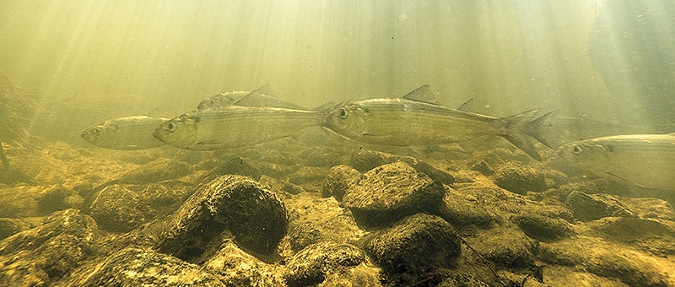Mid-Atlantic fisheries regulators are weighing whether to take additional steps to protect American shad and river herring as they migrate along the East Coast, as some new research suggests significant numbers of herring may be accidentally netted by offshore trawlers.
The Mid-Atlantic Fishery Management Council is scheduled to receive a staff-written white paper in August reviewing whether to move toward imposing tighter limits on the amount of shad and river herring that could be caught by offshore fleets pursuing another species, Atlantic mackerel. The council, which regulates commercial fishing within federal waters from New York to North Carolina, plans to make a decision at its October meeting.

The issue could have implications for depleted spawning runs of shad and river herring in many Chesapeake Bay rivers, where utilities, state and federal governments have invested tens of millions of dollars removing dams or building lifts and other ways for the fish to get past barriers that block their migrations to historic spawning grounds.
In April, Exelon Corp., owner of the Conowingo Dam on the Susquehanna River, agreed to a series of upgrades to its fish lift operation aimed at reviving spawning runs on the Bay’s largest tributary. The number of shad using the $12 million lift built in 1991 rose dramatically for about a decade, but has since declined precipitously. Blueback herring and alewife, known collectively as river herring, once outnumbered shad at the lift but have virtually disappeared in recent years.
But conservationists worry that improving fish passage or even removing dams, as has occurred in other rivers, may not be enough to restore populations because something outside the Bay may be affecting them. Shad and their cousins, river herring, are anadromous, meaning they spend much of their lives in the ocean but return to their native fresh water rivers to spawn.
Specifically, conservationists have voiced concern that significant numbers of shad and river herring may be netted by vessels trawling along the mid-Atlantic and New England coasts in federal waters — those more than 3 miles offshore — for other fish such as mackerel and Atlantic herring, another relative of the river herring.
The mid-Atlantic council imposed a cap in 2014 on that incidental catch, which conservationists hailed at the time. It tightened the cap last year, saying trawlers going after mackerel and other fish would have to stop fishing if their nets brought in as much as 82 metric tons, or 181,000 pounds, of river herring and shad. The reported bycatch has never come close to that cap; but conservationists complain that there haven’t been enough federal observers on the trawlers to be sure the reports are reliable.
“We’ve got industrial-scale fishing vessels targeting mackerel and Atlantic herring in the southern New England area, and we barely have any observer coverage on those vessels,” complained Roger Fleming, a lawyer with Earthjustice. “Some of those vessels can hold up to 1 million pounds of fish…They can virtually wipe out a river herring stock in one tow (of the net).”
River herring runs in rivers along much of the Atlantic coast have declined so much that conservationists petitioned to have them declared threatened, which would increase federal protections for them. The National Marine Fisheries Service declined to list them, a decision conservationists have challenged without success.
Through another lawsuit by Earthjustice, they won a separate court ruling directing fisheries officials to reconsider an earlier decision not to regulate the river herring catch at sea under the federal Magnuson-Stevenson Act. The mid-Atlantic council had previously decided against such a move, saying more time was needed to assess the effectiveness of the bycatch cap and other relatively recent conservation measures.
“The question is, are they in need of additional conservation and management under a federal fisheries management plan, in addition to what’s going on now?” asked Jason Didden, a fisheries management specialist with the council, who’s preparing the white paper.
Research published in the last few years suggests that even though the reported river herring catch hasn’t come close to hitting the cap, it could still be depressing some localized spawning populations of the fish.
In one 2013 study, scientists analyzing the DNA of river herring caught offshore found they included a number of different spawning stocks from different rivers and areas along the East Coast.
Another study published last year using DNA analysis found that the most depleted spawning populations of river herring were being disproportionately netted as bycatch by the fishing fleet pursuing Atlantic herring.
“The populations in southern New England, especially in and around Long Island Sound, and blueback populations in the mid-Atlantic region are getting hit harder than others,” said Eric Palkovacs, a biologist at the University of California, Santa Cruz, who was co-author of both studies.
The Chesapeake Bay population of blueback herring show up in the bycatch as well, Palkovacs added, though not many alewife from the estuary do.
“I think solving this bycatch problem is going to be critical for allowing the dam removals and fishway projects to start to work,” the researcher said. “Those types of projects are going to continue to be compromised until we solve this marine mortality.”
William Goldsborough, senior fisheries scientist for the Chesapeake Bay Foundation, said the studies are the first to fill in what he said has been a lack of information about river herring and shad being caught in ocean fisheries.
“When you see all the management efforts going on to try to rebuild (spawning) runs,” he said, “it doesn’t make sense we would allow that kind of waste of the few that are left.”
